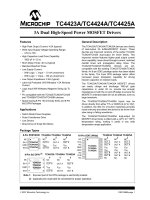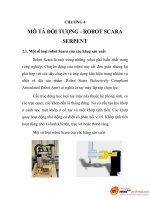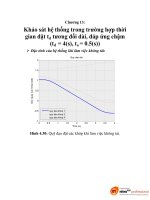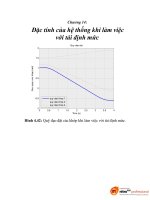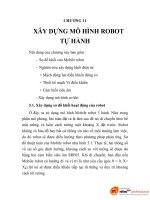Line Following Robot pps
Bạn đang xem bản rút gọn của tài liệu. Xem và tải ngay bản đầy đủ của tài liệu tại đây (149.71 KB, 17 trang )
Line Following
Robot
By,
Priyank Patil
Department of Information Technology
K. J. Somaiya College of Engineering
Mumbai, India
Line Follower
Page 2 of 17
Contents
1. Summary
2. Introduction
2.1. What is a line follower?
2.2. Why build a line follower?
2.3. Background
2.4. Prerequisites
2.5. The AVR microcontroller
3. Overview
3.1. Block Diagram and Architectural Overview
3.2. The Algorithm
4. Implementation
4.1. Sensor Circuit
4.2. Motor Interface and Control Circuit
4.3. Source Code
5. Possible Improvements
6. References and Resources
6.1. Books and Links
6.2. Tools of the trade
6.3. Electronic shops
6.4. Parts and Prices
Line Follower
Page 3 of 17
Summary
The purpose of this document is to help you build a Line Following Robot.
Starting with an overview of the system the document would cover implementation
details like circuits and algorithms, followed by some suggestions on improving the
design.
The ‘Reference and Resources’ page has a list of relevant books, websites, electronic
shops and commonly used parts & their prices.
Line Follower
Page 4 of 17
Introduction
What is a line follower?
Line follower is a machine that can follow a path. The path can be visible like a black
line on a white surface (or vice-versa) or it can be invisible like a magnetic field.
Why build a line follower?
Sensing a line and maneuvering the robot to stay on course, while constantly correcting
wrong moves using feedback mechanism forms a simple yet effective closed loop
system. As a programmer you get an opportunity to ‘teach’ the robot how to follow the
line thus giving it a human-like property of responding to stimuli.
Practical applications of a line follower : Automated cars running on roads with
embedded magnets; guidance system for industrial robots moving on shop floor etc.
Prerequisites:
Knowledge of basic digital and analog electronics.
(A course on Digital Design and Electronic Devices & Circuits would be helpful)
C Programming
Sheer interest, an innovative brain and perseverance!
Background:
I started with building a parallel port based robot which could be controlled
manually by a keyboard. On the robot side was an arrangement of relays connected to
parallel port pins via opto-couplers.
The next version was a true computer controlled line follower. It had sensors
connected to the status pins of the parallel port. A program running on the computer
polled the status register of the parallel port hundreds of times every second and sent
control signals accordingly through the data pins.
The drawbacks of using a personal computer were soon clear –
It’s difficult to control speed of motors
As cable length increases signal strength decreases and latency increases.
A long multi core cable for parallel data transfer is expensive.
The robot is not portable if you use a desktop PC.
The obvious next step was to build an onboard control circuit; the options – a
hardwired logic circuit or a uC. Since I had no knowledge of uC at that time, I
implemented a hardwired logic circuit using multiplexers. It basically mapped input from
four sensors to four outputs for the motor driver according to a truth table. Though it
worked fine, it could show no intelligence – like coming back on line after losing it, or
doing something special when say the line ended. To get around this problem and add
some cool features, using a microcontroller was the best option.
Line Follower
Page 5 of 17
The AVR microcontroller:
“Atmel's AVR® microcontrollers have a RISC core running single cycle
instructions and a well-defined I/O structure that limits the need for external
components. Internal oscillators, timers, UART, SPI, pull-up resistors, pulse
width modulation, ADC, analog comparator and watch-dog timers are some of
the features you will find in AVR devices.
AVR instructions are tuned to decrease the size of the program whether the code
is written in C or Assembly. With on-chip in-system programmable Flash and
EEPROM, the AVR is a perfect choice in order to optimize cost and get product to
the market quickly.”
-
Apart form this almost all AVRs support In System Programming (ISP) i.e. you
can reprogram it without removing it from the circuit. This comes very handy
when prototyping a design or upgrading a built-up system. Also the programmer
used for ISP is easier to build compared to the parallel programmer required for
many old uCs. Most AVR chips also support Boot Loaders which take the idea
of In System Programming to a new level. Features like I
2
C bus interface make
adding external devices a cakewalk. While most popular uCs require at least a few
external components like crystal, caps and pull-up resistors, with AVR the
number can be as low as zero!
Cost: AVR = PIC > 8051 (by 8051 I mean the 8051 family)
Availability: AVR = PIC <8051
Speed: AVR > PIC > 8051
Built-in Peripherals: This one is difficult to answer since all uC families offer
comparable features in their different chips. For a just comparison, I would rather
say that for a given price AVR = PIC > 8051.
Tools and Resources: 8051 has been around from many years now, consequently
there are more tools available for working with it. Being a part of many
engineering courses, there is a huge communitiy of people that can help you out
with 8051; same with books and online resources. In spite of being new the AVR
has a neat tool chain (See ‘References and Resources‘). Availability of online
resources and books is fast increasing.
Here, 8051 > AVR = PIC
Line Follower
Page 6 of 17
Overview
Block Diagram
The robot uses IR sensors to sense the line, an array of 8 IR LEDs (Tx) and sensors (Rx), facing
the ground has been used in this setup. The output of the sensors is an analog signal which
depends on the amount of light reflected back, this analog signal is given to the comparator to
produce 0s and 1s which are then fed to the uC.
L4 L3 L2 L1 R1 R2 R3 R4
Left Center Right
Sensor Array
Starting from the center, the sensors on the left are named L1, L2, L3, L4 and those on the right
are named R1, R2, R3, R4.
Let us assume that when a sensor is on the line it reads 0 and when it is off the line it reads 1
The uC decides the next move according to the algorithm given below which tries to position the
robot such that L1 and R1 both read 0 and the rest read 1.
L4 L3 L2 L1 R1 R2 R3 R4
1 1 1 0 0 1 1 1
Left Center Right
Desired State L1=R1=0, and Rest=1
Line Follower
Page 7 of 17
Algorithm:
1. L= leftmost sensor which reads 0; R= rightmost sensor which reads 0.
If no sensor on Left (or Right) is 0 then L (or R) equals 0;
Ex:
Left Center Right
Here L=3 R=0
Left Center Right
Here L=2 R=4
2. If all sensors read 1 go to step 3,
else,
If L>R Move Left
If L<R Move Right
If L=R Move Forward
Goto step 4
3. Move Clockwise if line was last seen on Right
Move Counter Clockwise if line was last seen on Left
Repeat step 3 till line is found.
4. Goto step 1.
L4 L3 L2 L1 R1 R2 R3 R4
1 0 0 1 1 1 1 1
L4 L3 L2 L1 R1 R2 R3 R4
1 1 0 0 0 0 0 0
Line Follower
Page 8 of 17
Implementation
Sensor Circuit:
To get a good voltage swing , the value of R1 must be carefully chosen. If R
sensor =
a when no
light falls on it and R
sensor
= b when light falls on it. The difference in the two potentials is:
V
cc
* { a/(a+R1) - b/(b+R1) }
Relative voltage swing = Actual Voltage Swing / V
cc
= V
cc
* { a/(a+R1) - b/(b+R1) } / V
cc
= a/(a+R1) - b/(b+R1)
The resistance of the sensor decreases
when IR light falls on it. A good
sensor will have near zero resistance
in presence of light and a very large
resistance in absence of light.
We have used this property of the
sensor to form a potential divider.
The potential at point ‘2’ is
R
sensor / (
R
sensor +
R
1).
Again, a good sensor circuit should
give maximum change in potential at
point ‘2’ for no-light and bright-
light
conditions. This is especially
important if you plan to use an ADC
in place of the comparator
Line Follower
Page 9 of 17
The sensor I used had a = 930 K and b = 36 K. If we plot a curve of the voltage swing over a
range of values of R1 we can see that the maximum swing is obtained at R1= 150 K (use calculus
for an accurate value).
There is a catch though, with such high resistance, the current is very small and hence susceptible
to be distorted by noise. The solution is to strike a balance between sensitivity and noise
immunity. I chose value of R1 as 60 K. Your choice would depend on the ‘a’ and ‘b’ values of
your sensor.
If you found this part confusing, use a 10K resistor straightaway, as long as you are using a
comparator it won’t matter much.
Motor Interface and Control Circuit:
The 8 sensors are connected to PORTA.
You need not connect anything to AVCC and AREF, it is required only if ADC is used.
The L298 Motor Driver has 4 inputs to control the motion of the motors and two enable inputs
which are used for switching the motors on and off. To control the speed of the motors a PWM
waveform with variable duty cycle is applied to the enable pins. Rapidly switching the voltage
between Vs and GND gives an effective voltage between Vs and GND whose value depends on
the duty cycle of PWM. 100% duty cycle corresponds to voltage equal to Vs, 50 % corresponds
to 0.5Vs and so on. The 1N4004 diodes are used to prevent back EMF of the motors from
disturbing the remaining circuit. Many circuits use L293D for motor control, I chose L298 as it
has current capacity of 2A per channel @ 45V compared to 0.6 A @ 36 V of a L293D. L293D’s
package is not suitable for attaching a good heat sink, practically you can’t use it above 16V
Line Follower
Page 10 of 17
without frying it. L298 on the other hand works happily at 16V without a heat sink, though it is
always better to use one.
Internal Schematic of L298
Truth Table for controlling the direction of motion of a DC motor
Line Follower
Page 11 of 17
Source Code
/*****************************************************
Project : Line Follower
Version :
Date : 2/19/2006
Author : Priyank
Company : Home
Comments:
Chip type : ATmega16
Program type : Application
Clock frequency : 7.372800 MHz
Memory model : Small
External SRAM size : 0
Data Stack size : 256
*****************************************************/
//#define debug 1
#include <mega16.h>
#include <delay.h>
#ifdef debug
#include <stdio.h>
#endif
#define FWD 0xAA
#define REV 0x55
#define R 0x22
#define L 0x88
#define CW 0x99
#define CCW 0x66
#define STOP 0x00
#define B 0xFF
#define RSPEED OCR1AL
#define LSPEED OCR1BL
#define SPEED0 255
#define SPEED1 0
#define SPEED2 0
#define SPEED3 0
#define MAX 3
#define HMAX 1
void move (unsigned char dir,unsigned char delay,unsigned char power);
unsigned char i,rdev,ldev,ip,delay,dir,power,dirl,history[MAX],hcount=0,rotpow;
#ifdef debug
unsigned char rep=0,prev=0;
#endif
void main(void)
{
// Input/Output Ports initialization
// Port A initialization
// Func7=In Func6=In Func5=In Func4=In Func3=In Func2=In Func1=In Func0=In
Line Follower
Page 12 of 17
// State7=T State6=T State5=T State4=T State3=T State2=T State1=T State0=T
PORTA=0x00;
DDRA=0x00;
// Port B initialization
// Func7=In Func6=In Func5=In Func4=In Func3=In Func2=In Func1=In Func0=In
// State7=T State6=T State5=T State4=T State3=T State2=T State1=T State0=T
PORTB=0x00;
DDRB=0x00;
// Port C initialization
// Func7=In Func6=In Func5=In Func4=In Func3=In Func2=In Func1=In Func0=In
// State7=T State6=T State5=T State4=T State3=T State2=T State1=T State0=T
PORTC=0x00;
DDRC=0xFF;
// Port D initialization
// Func7=In Func6=In Func5=Out Func4=Out Func3=In Func2=In Func1=In Func0=In
// State7=T State6=T State5=0 State4=0 State3=T State2=T State1=T State0=T
PORTD=0x00;
DDRD=0x30;
// Timer/Counter 0 initialization
// Clock source: System Clock
// Clock value: Timer 0 Stopped
// Mode: Normal top=FFh
// OC0 output: Disconnected
TCCR0=0x00;
TCNT0=0x00;
OCR0=0x00;
// Timer/Counter 1 initialization
// Clock source: System Clock
// Clock value: 921.600 kHz
// Mode: Fast PWM top=00FFh
// OC1A output: Non-Inv.
// OC1B output: Non-Inv.
// Noise Canceler: Off
// Input Capture on Falling Edge
TCCR1A=0xA1;
TCCR1B=0x0A;
TCNT1H=0x00;
TCNT1L=0x00;
ICR1H=0x00;
ICR1L=0x00;
OCR1AH=0x00;
OCR1AL=0xFF;
OCR1BH=0x00;
OCR1BL=0xFF;
// Timer/Counter 2 initialization
// Clock source: System Clock
// Clock value: Timer 2 Stopped
// Mode: Normal top=FFh
// OC2 output: Disconnected
ASSR=0x00;
TCCR2=0x00;
Line Follower
Page 13 of 17
TCNT2=0x00;
OCR2=0x00;
// External Interrupt(s) initialization
// INT0: Off
// INT1: Off
// INT2: Off
MCUCR=0x00;
MCUCSR=0x00;
#ifdef debug
// USART initialization
// Communication Parameters: 8 Data, 1 Stop, No Parity
// USART Receiver: On
// USART Transmitter: On
// USART Mode: Asynchronous
// USART Baud rate: 57600
UCSRA=0x00;
UCSRB=0x18;
UCSRC=0x86;
UBRRH=0x00;
UBRRL=0x07;
#endif
// Timer(s)/Counter(s) Interrupt(s) initialization
TIMSK=0x00;
// Analog Comparator initialization
// Analog Comparator: Off
// Analog Comparator Input Capture by Timer/Counter 1: Off
ACSR=0x80;
SFIOR=0x00;
while (1){
#ifdef debug
if(rep<255)
rep++;
if(prev!=PINA) {
prev=PINA;
printf("%u\r",rep);
for(i=0;i<8;i++)
printf("%u\t",(prev>>i)&0x01);
rep=0;
}
#endif
if(PINA!=255){
rotpow=255;
ldev=rdev=0;
if(PINA.3==0)
rdev=1;
if(PINA.2==0)
rdev=2;
if(PINA.1==0)
rdev=3;
Line Follower
Page 14 of 17
if(PINA.0==0)
rdev=4;
if(PINA.4==0)
ldev=1;
if(PINA.5==0)
ldev=2;
if(PINA.6==0)
ldev=3;
if(PINA.7==0)
ldev=4;
if(rdev>ldev)
move(R,0,195+12*rdev);
if(rdev<ldev)
move(L,0,195+12*ldev);
if(rdev==ldev)
move(FWD,0,200);
}
else {
for(i=0,dirl=0;i<MAX;i++) {
if(history[i]==L)
{dirl++;}
}
if(rotpow<160) {rotpow=160;}
if(rotpow<255) {rotpow++;}
if(dirl>HMAX)
{move(CW,0,rotpow);}
else
{move(CCW,0,rotpow);}
}
};
}
void move (unsigned char dir,unsigned char delay,unsigned char power) {
PORTC=dir;
if(dir==L || dir==R) {
hcount=(hcount+1)%MAX;
history[hcount]=dir;
}
LSPEED=RSPEED=255;//power;
//delay_ms(delay);
}
Possible Improvements:
-Use of differential steering with gradual change in wheel speeds.
-Use of Hysteresis in sensor circuit using LM339
-Use of ADC so that the exact position of the line can be interpolated
-Use of Wheel Chair or three wheel drive to reduce traction.
-General improvements like using a low dropout voltage regulator, lighter chassis etc
Line Follower
Page 15 of 17
References and Resources
Books:
Programming and Customizing the AVR Microcontroller – Dhananjay V. Gadre
Parallel Port Complete – Jan Axelson
Links:
Atmel Corp.
Makers of the AVR microcontroller
AVRbeginners.net
AVR assembler tutorial
Tutorial for learning assembly language for the AVR-Single-Chip-Processors
AT90Sxxxx from ATMEL with practical examples.
One of the best sites AVR sites
WinAVR
An open source C compiler for AVR
PonyProg
A widely used programmer. Support for newer chips is added periodically. Can also
program PICs and EEPROMS
Basic Electronics
Williamson Labs
Nice animated tutorials, articles and project ideas.
Small Robot Sensors
Robotics India
An Indian site devoted to robotics. Must see
Seattle Robotics Society
Line Follower
Page 16 of 17
Line Follower ROBOT
Award winner from VingPeaw Competition 2543, the robot built with 2051, L293D, and
four IR sensors. Simple circuit and platform, quick tracking and
Easy to understand program using C language.
Tools: AVR Studio
For writing code in assembly and simulation of code. Current versions has AVR-GCC
plug-in to write code in C.
Compilers: IAR, Image Craft , Code Vision AVR, WinAVR
Programmers: Pony Prog, AVR Dude, AVRISP and many more.
Evaluation Boards: STK200, STK500 from Kanda Systems
Shops:
Motors:
1. Mechtex - Mulund, Mumbai
2. Servo Electronics - Lamington road, Mumbai Phone:56346573
3. Bombay Electronics - Lamington Road, Mumbai
Electronics:
1. Visha Electronics - Lamington road, Mumbai
[Programmer for 8051, PIC and AVR available]
Phone: 23862650 / 23862622
2. Gala Electronics - Lamington road, Mumbai
3. Chip Components - Lamington road, Mumbai
Telephone: 56390468 / 56587005
Parts and Prices:
Part Approximate Price in Indian Rupees
Visible Light Leds
White or Bicoloured
1.00
5.00
IR LED
IR Sensor
3.00
7.00
Capacitor (small values)
Capacitor (large values / electrolytic)
0.25 to 2.00
2.00 to 20.00 Or more
Resistors (1/4 W)
Variable Resistor (Preset)
Variable Resistor (Pot)
0.25
2.50
8.00
Microcontrollers
AT89C2051 (8051 Core)
AT89C51 (8051 Core)
AT89S52 (8051 Core)
PIC16F84A (PIC Core)
40 to 450
40
60
150
120
Line Follower
Page 17 of 17
ATmega8 (AVR Core)
ATmega16 (AVR Core)
ATmega32 (AVR Core)
ATmega128 (AVR Core)
90
150
300
425
Transistors
Low power Eg: BC547
Power Transistor Eg: TIP31C
1.50 to 15 or more
1.50
15.00
Connectors 1.00 per pin
Optocoupler (MCT2E) 8.00
Common Tools
Soldering Iron
Solder metal
Solder Flux
Desoldering Wick
Breadboard
Wire Stripper
150 (typical) to 400
25.00
5.00
5.00
80.00 to 100.00
25.00
Common ICs
Voltage Regulators (78XX),
LM324,IC555 etc
MAX232
ULN 2003 / ULN 2803
TSOP17XX
L298, L293, L293D
5.00
20.00
14.50
17.00
70.00
IC Programmers
Homemade (Support fewer devices,
support only serial programming, not as
rugged)
Eg: PonyProg ( )
Readymade (Support many chips, support
parallel programming, easy to use,
rugged)
20.00 to 80.00
2500 to 25000
Wireless Modules 700.00
Parallel Port / Serial Port Add on Card for
PC
500.00
Universal PCB 10.00 to 50.00
You may drop your feedback at .
Priyank Patil
KJ Somaiya CoE – Information Technology
VidyaVihar,
Mumbai

